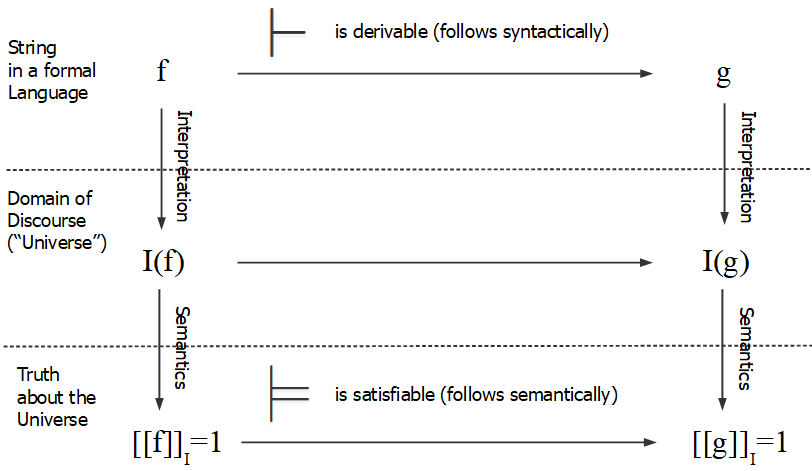◀ ▲ ▶Branches / Logic / Chapter: Putting it All Together - Syntax and Semantics of a Logical Calculus
Chapter: Putting it All Together - Syntax and Semantics of a Logical Calculus
The goal of the basic concepts introduced so far was to link the syntactical and the semantic levels of a formal language. The following figure demonstrates these two levels:

The advantage of the derivability property "$\vdash$" is that it is defined in a way capable for automation.
Even a machine, (we have called the proving machine PM) would be able to derive one string from another formally (i.e. in a formal language $L$),
according to its syntax and the defined rules of inference.
The disadvantage of the derivability property "$\vdash$" is that it only operates on strings without any meaning.
But we want to construct a logical calculus to be able to derive true statements about a universe $U$,
we call the domain of discourse. This is where interpretation $I(U,L)$ comes into play with its valuation function $[[]]_I$.
Ideally, our logical calculus should fulfill some desirable properties:
- From $\vdash g$ we should always be able to conclude $\models g$, i.e. whenever we are able to derive a formula $g$ syntactically, it should also follow semantically - i.e. be a valid statement about our universe.
- From $\models g$ we should always be able to conclude $\vdash g$, i.e. every valid statement $g$ should be also derivable.
- If we are able to derive $g$, we should never be able to derive its negation $\neg g$.
- If we are not able to derive the negation $\neg g$, we should always be able to derive $g$.
Now, we will introduce these desirable properties of a logical calculus as formal definitions.
Table of Contents
- Definition: Soundness and Completeness of a Logical Calculus
- Definition: Consistency and Negation-Completeness of a Logical Calculus
- Definition: Negation of a String
Thank you to the contributors under CC BY-SA 4.0! 

- Github:
-

References
Bibliography
- Hoffmann, Dirk W.: "Grenzen der Mathematik - Eine Reise durch die Kerngebiete der mathematischen Logik", Spektrum Akademischer Verlag, 2011
- Beierle, C.; Kern-Isberner, G.: "Methoden wissensbasierter Systeme", Vieweg, 2000
